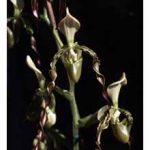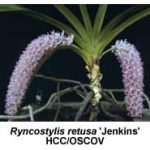For many years there was little contact between Burma (Myanmar) and the western world, and even now few choose to visit Burma because of its poor stance on human rights. Consequently, there has been little or no recent trade in orchids from Burma, although that does not mean that their orchids are unknown to us. Fortunately, political borders offer no restriction to orchid populations, and Burma and the adjoining parts of Thailand have many orchids in common. Shipments of orchids from Thailand to Australia were quite common until the introduction of CITES regulations governing trade in bush-collected orchid species.
Moulmein was a household word among orchid growers in the nineteenth century, when many Burmese orchids were discovered and collected there. Yet today I suspect that few have ever heard of the city of Moulmein and that even fewer know its location. My atlas reveals that it is located about 150 km across the Gulf of Martaban from the capital city, Rangoon, now known as Yangon. Some 400 orchid species grow (or more likely once grew) within a 150 Km radius of Moulmein.
The Reverend Charles Parish, who spent 25 years as a missionary in Moulmein, introduced many of these orchids to European cultivation. On first arrival in 1852 he collected orchids to beautify his home and mission but soon the study of orchids became a passion, which lasted throughout his long stay in Burma and continued into his retirement in Somerset. His mission work cannot have taxed him excessively, because he once wrote “hardly a day passed on which I either did not draw or examine microscopically some one orchid or another”.
Parish sent regular shipments of orchids back to John Lindley and Joseph Hooker in England for scientific study, and also collaborated with an army officer, Colonel Benson, in sending other shipments for sale. Many were new to science and quite a few desirable species now bear his name, Cymbidium parishii, Paphiopedilum parishii and Phalaenopsis parishii among them. Parish found and identified 350 orchid species, and grew 150 of them in his garden in Moulmein. By no means were all 350 species warm-growing, as the altitude rises rapidly as one proceeds inland, and some peaks in the Dawna Range reach 2000 m in height.
In 1965 the Burmese hobbyist U San Hla provided an interesting account of the orchids cultivated in Moulmein and the conditions under which they flourished (Amer. Orchid Soc. Bull., 1965, 35, 309). Orchids then common in Moulmein gardens included Dendrobium aphyllum (formerly known as D. pierardii), D. formosum, D. scabrilingue, D. secundum, Calanthe rosea and Phalaenopsis cornu-cervi. Rhyncostylis retusa was not often cultivated because it “grew like a weed” on roadside trees!
Those who believe that they grow D. aphyllum well may be interested to learn that in Moulmein its canes may reach 1.5 m in length during the monsoon season (mid-May to October), when the average daily rainfall is 25 mm. The ‘cool’ season (November to February) follows and the plants flower as the hot season (March and April) begins. As the temperature in Moulmein seldom exceeds 33°C, exceptionally high temperatures are not essential. However, it should be noted that the mean minimum temperature in Moulmein is 26 °C and that the lowest temperature ever recorded there is 15°C! Nobody grew native orchids for the flower trade in Moulmein in 1956, because the blooms could be collected for market from the wild. Spikes of Dendrobium lindleyi (then D. aggregatum), D. moschatum, D. pulchellum, Aerides odoratum and Rhyncostylis retusa were sold in the local market for the equivalent of one cent each.


